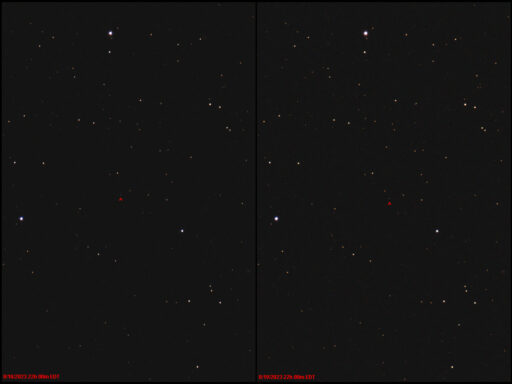
Telescope: Unitron 510 5” f/16 refractor, Atlas EQ-G
Camera: Canon EOS Ra full frame DSLR
Filter: 2” Baader Fringe Killer (Minus Violet)
Guide scope: Williams Optics 50mm Guidescope, ASI290MM, PHD
Exposure: 43x60sec (8/18), 39x60sec (8/19), ISO 1600, saved as RAW
Darks: Internal (Long Exposure Noise Reduction)
Flats: 32×1/125s sky flats taken at dusk
Average Light Pollution: Bortle 8, poor transparency, haze
Lensed Sky Quality Meter: 17.7 (8/18), 18.0 (8/19) mag/arc-sec^2
Stacking: Mean with a 1-sigma clip
White Balance: Nebulosity Automatic
Software: Backyard EOS, Deepsky Stacker, Nebulosity, Photoshop
This is my annual pilgrimage to the frozen out-lands beyond the orbit of Neptune and my homage to Clyde Tombaugh who discovered Pluto on photographic plates taken at the Lowell Observatory in 1930. This year was special in that it presented an opportunity to image a classic target with a classic telescope. Fun fact; while the discovery images of Pluto were taken with a 13 inch astrograph, confirming images were taken at the same time with a 5” refractor mounted along side the main camera. And yes, Pluto was reported to have been detected on these images, though I have never seen them published.
These two images were taken almost exactly 24 hours apart showing Pluto’s apparent motion against the background stars (marked by red ‘^’ symbols). I say ‘apparent’ as this motion has more to do with the Earth than Pluto. The true motion of the outer planets is from west to east, but in these images Pluto appears to move from east to west (retrograde). This results from our changing perspective as the Earth sweeps past Pluto in its orbit around the sun. Pluto will remain in retrograde motion until October 10th.
When these images were taken Pluto was 3.15 billion miles away shining at Mv 14.4. The sun’s illumination took approximately 4.7 hours to reach Pluto and the feeble reflected sunlight took another 4.7 hours to make the journey back to the Earth.
Pluto is currently well placed in the southern sky at dusk. (Photo credit: John Graham, 8/18 & 8/19/2023)
Recent Comments